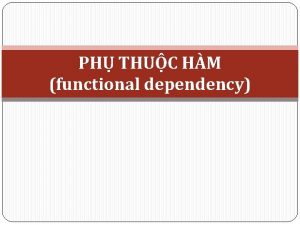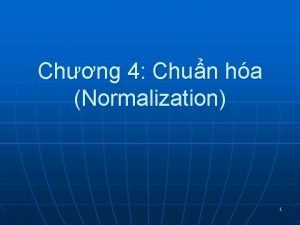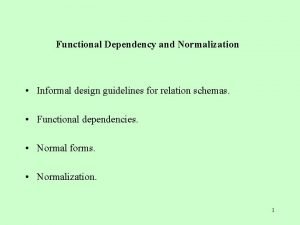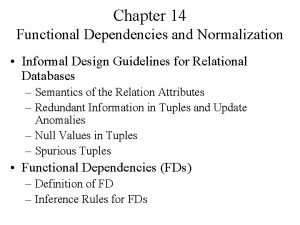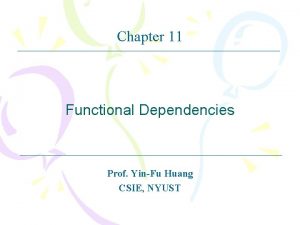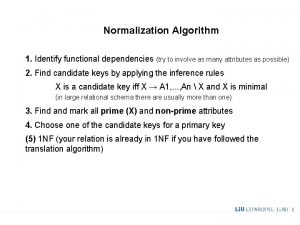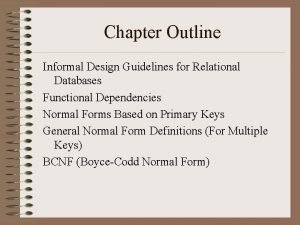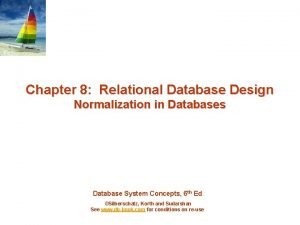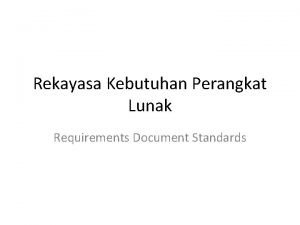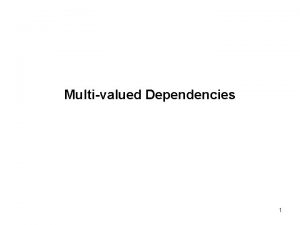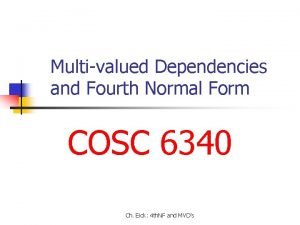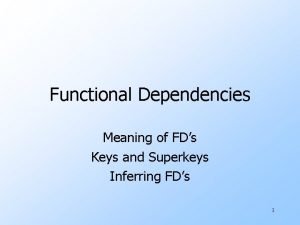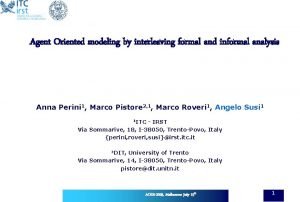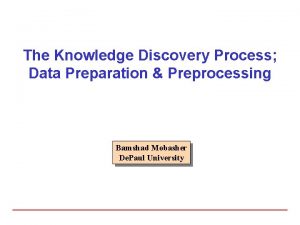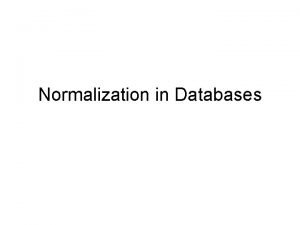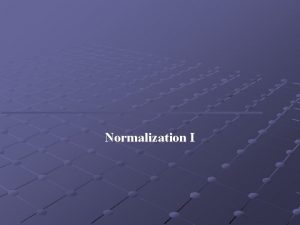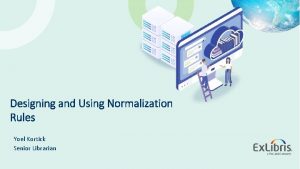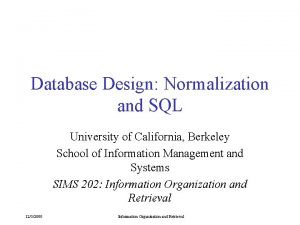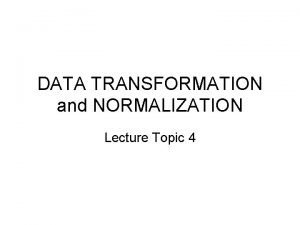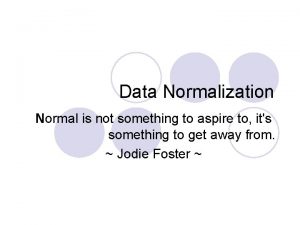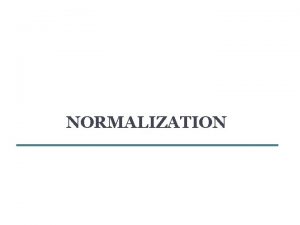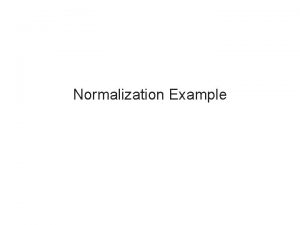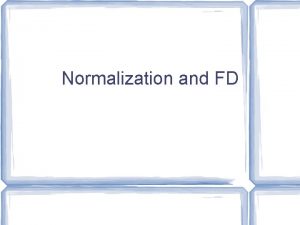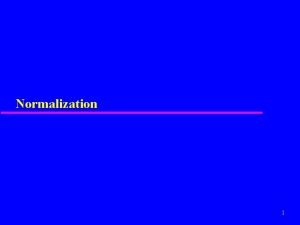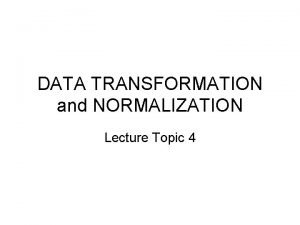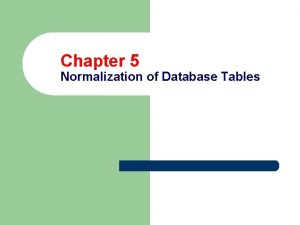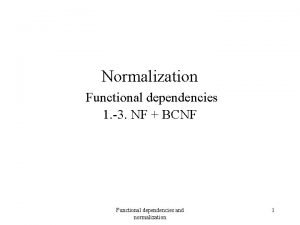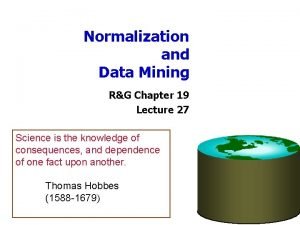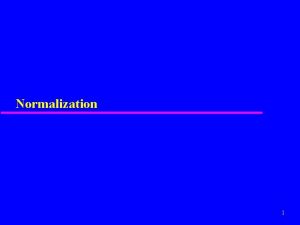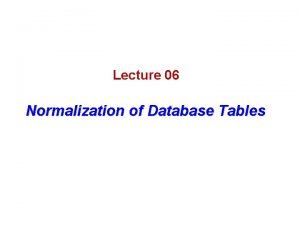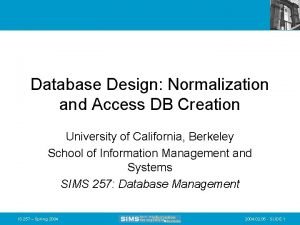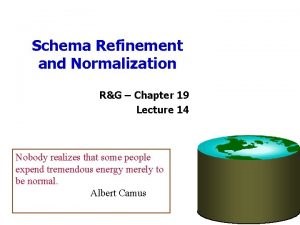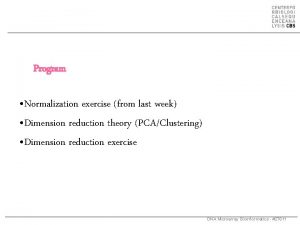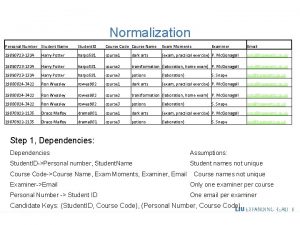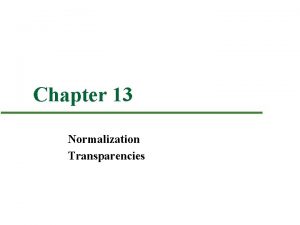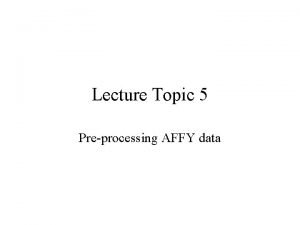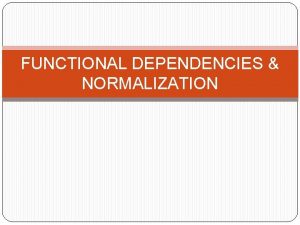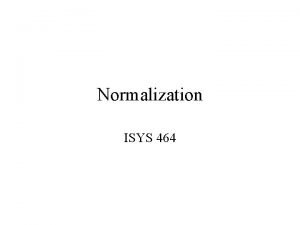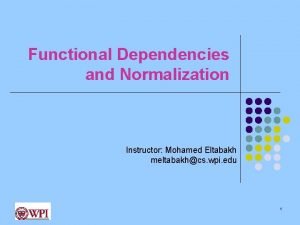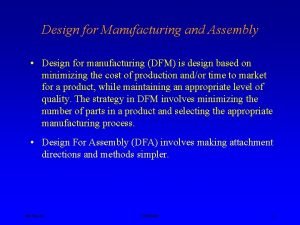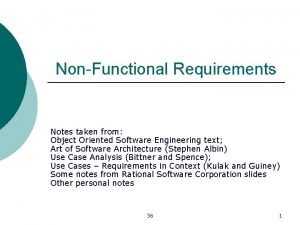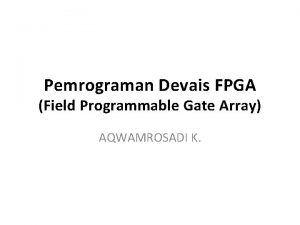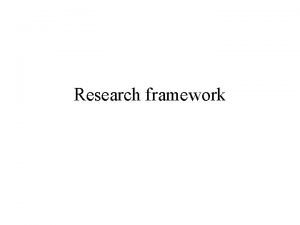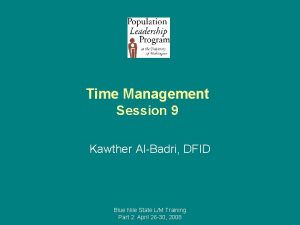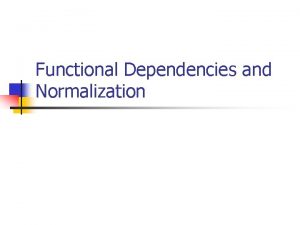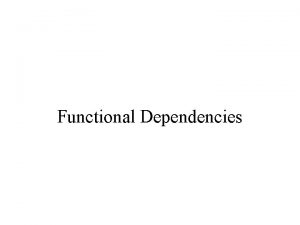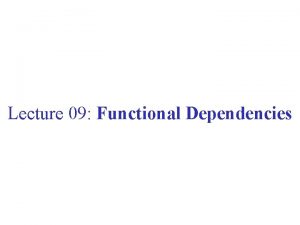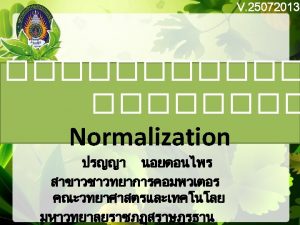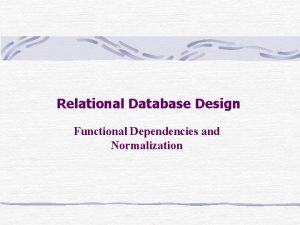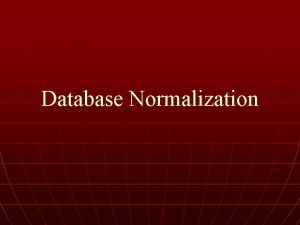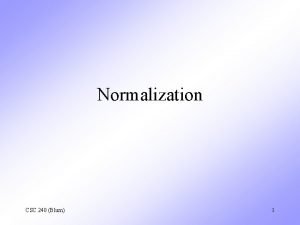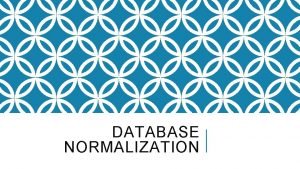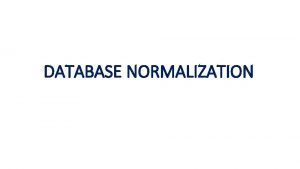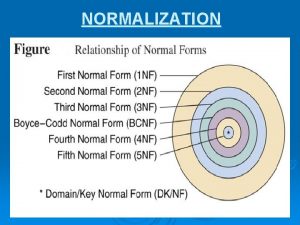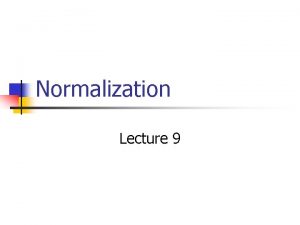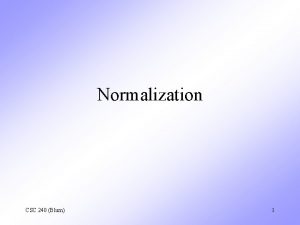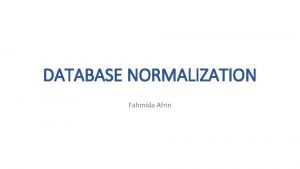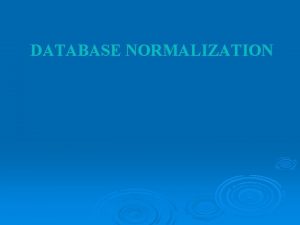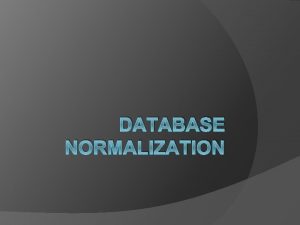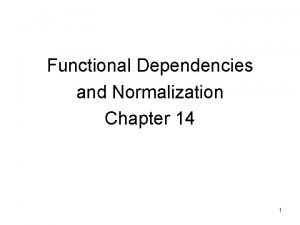FUNCTIONAL DEPENDENCIES NORMALIZATION Outline 1 Informal Design Guidelines






























































































- Slides: 94

FUNCTIONAL DEPENDENCIES & NORMALIZATION

Outline 1 Informal Design Guidelines for Relational Databases 1. 1 Semantics of the Relation Attributes 1. 2 Redundant Information in Tuples and Update Anomalies 1. 3 Null Values in Tuples 1. 4 Spurious Tuples 2 Functional Dependencies (FDs) 2. 1 Definition of FD 2. 2 Inference Rules for FDs 2. 3 Equivalence of Sets of FDs 2. 4 Minimal Sets of FDs

Outline(contd. ) 3 Normal Forms Based on Primary Keys 3. 1 Normalization of Relations 3. 2 Practical Use of Normal Forms 3. 3 Definitions of Keys and Attributes Participating in Keys 3. 4 First Normal Form 3. 5 Second Normal Form 3. 6 Third Normal Form 4 General Normal Form Definitions (For Multiple Keys) 5 BCNF (Boyce-Codd Normal Form)

Why normalization? Formal measure of why one grouping of attributes into a relation schema may be better than the other. In this chapter theory behind the evaluation of relational schemas for design quality is discussed. In other words to measure formally why one set of groupings of attributes into relation schemas is better than another. Two levels of relation schemas The logical or conceptual view How users interpret the relation schemas and the meaning of their attributes. Implementation or storage view How the tuples in the base relation are stored and updated. The storage "base relation" level

1 Informal Design Guidelines for Relational Databases (1) What is relational database design? The grouping of attributes to form "good" relation schemas Two levels of relation schemas The logical "user view" level The storage "base relation" level Design is concerned mainly with base relations What are the criteria for "good" base relations?

1. 1 Semantics of the Relation Attributes GUIDELINE 1: Informally, each tuple in a relation should represent one entity or relationship instance. (Applies to individual relations and their attributes). Attributes of different entities (EMPLOYEEs, DEPARTMENTs, PROJECTs) should not be mixed in the same relation Only foreign keys should be used to refer to other entities Entity and relationship attributes should be kept apart as much as possible. Bottom Line: Design a schema that can be explained easily relation by relation. The semantics of attributes should be easy to interpret.

A COMPANY relational database schema

A sample relational database state corresponding to COMPANY database

A simplified COMPANY relational database schema

1. 2 Redundant Information in Tuples and Update Anomalies Mixing attributes of multiple entities may cause problems Information is stored redundantly wasting storage Problems with update anomalies Insertion anomalies Deletion anomalies Modification anomalies

EXAMPLE OF AN UPDATE ANOMALY (1) Consider the relation: EMP_PROJ ( Emp#, Proj#, Ename, Pname, No_hours) Update Anomaly: Changing the name of project number P 1 from “Billing” to “Customer. Accounting” may cause this update to be made for all 100 employees working on project P 1.

EXAMPLE OF AN UPDATE ANOMALY (2) Insert Anomaly: Cannot insert a project unless an employee is assigned to. Inversely - Cannot insert an employee unless an he/she is assigned to a project. Delete Anomaly: When a project is deleted, it will result in deleting all the employees who work on that project. Alternately, if an employee is the sole employee on a project, deleting that employee would result in deleting the corresponding project.

Two relation schemas suffering from update anomalies

Example States for EMP_DEPT and EMP_PROJ

Guideline to Redundant Information in Tuples and Update Anomalies GUIDELINE 2: Design a schema that does not suffer from the insertion, deletion and update anomalies. If there any present, then note them so that applications can be made to take them into account

Problems with Null Values If many attributes are grouped together as a fat relation, it gives rise to many nulls in the tuples. Waste storage Problems in understanding the meaning of the attributes Difficult while using Nulls in aggregate operators like count or sum

1. 3 Null Values in Tuples GUIDELINE 3: Relations should be designed such that their tuples will have as few NULL values as possible Attributes that are NULL frequently could be placed in separate relations (with the primary key) Reasons for nulls: attribute not applicable or invalid attribute value unknown (may exist) value known to exist, but unavailable

1. 4 Spurious Tuples Bad designs for a relational database may result in erroneous results for certain JOIN operations The "lossless join" property is used to guarantee meaningful results for join operations GUIDELINE 4: The relations should be designed to satisfy the lossless join condition. No spurious tuples should be generated by doing a natural-join of any relations.

Example of Spurious Tuples

Example of Spurious Tuples generation

Generation of spurious tuples The two relations EMP_PROJ 1 and EMP_LOCS as the base relations of EMP_PROJ, is not a good schema design. Problem is if a Natural Join is performed on the above two relations it produces more tuples than original set of tuples in EMP_PROJ. These additional tuples that were not in EMP_PROJ are called spurious tuples because they represent spurious or wrong information that is not valid. This is because the PLOCATION attribute which is used for joining is neither a primary key, nor a foreign key in either EMP_LOCS AND EMP_PROJ 1.

Spurious Tuples (2) There are two important properties of decompositions: (a) non-additive or losslessness of the corresponding join (b) preservation of the functional dependencies. Note that property (a) is extremely important and cannot be sacrificed. Property (b) is less stringent and may be sacrificed.

Summary and Discussion of Design Guidelines Anomalies cause redundant work to be done during Insertion Modification Deletion Waste of storage space due to nulls and difficulty of performing aggregation operations and joins due to null values Generation of invalid and spurious data during joins on improperly related base relations.

2. 1 Functional Dependencies (1) Functional dependencies (FDs) Is a constraint between two sets of attributes from the database. Assumption The entire database is a single universal relation schema R={A 1, A 2…An} Where A 1, A 2 … are the attributes.

2. 1 Functional Dependencies (1) Functional dependencies (FDs) are used to specify formal measures of the "goodness" of relational designs FDs and keys are used to define normal forms for relations FDs are constraints that are derived from the meaning and interrelationships of the data attributes A set of attributes X functionally determines a set of attributes Y if the value of X determines a unique value for Y

Functional Dependencies (2) X -> Y holds if whenever two tuples have the same value for X, they must have the same value for Y For any two tuples t 1 and t 2 in any relation instance r(R): If t 1[X]=t 2[X], then t 1[Y]=t 2[Y] X -> Y in R specifies a constraint on all relation instances r(R) Written as X -> Y; can be displayed graphically on a relation schema as in Figures. ( denoted by the arrow: ). FDs are derived from the real-world constraints on the attributes

Examples of FD constraints (1) social security number determines employee name SSN -> ENAME project number determines project name and location PNUMBER -> {PNAME, PLOCATION} employee ssn and project number determines the hours per week that the employee works on the project {SSN, PNUMBER} -> HOURS

Graphical representation of Functional Dependencies

Examples of FD constraints (2) An FD is a property of the attributes in the schema R, not of a particular legal relation state r of R. It must be defined explicitly by someone who knows the semantics of the attributes of R. The constraint must hold on every relation instance r(R) If K is a key of R, then K functionally determines all attributes in R (since we never have two distinct tuples with t 1[K]=t 2[K])

Relation state of TEACHER -> COURSE TEACHER COURSE TEXT -> COURSE Smith Data Structures Bartram Smith Data Al-Nour Management Hall Compilers Hoffmann Brown ooad Augenthaler

Redundant functional dependencies Given a set F of FDs, a FD A B of F is said to be redundant with respect to the FDs of F iff A B can be derived from the set of FDs F-{A B} Redundant FDs are extra and unnecessary and can be safely removed from the set F. Eliminating redundant FDs allows us to minimize the set of FDs. Membership Algorithm helps us to determine redundant FDs.

Membership Algorithm Assuming F is a set of functional dependencies with A B ε F. To determine if A B is redundant with respect to the other FDs of the set F 1. Remove A B. Initialize G=F-{A B}. If G≠ 0 proceed to step 2. else stop executing the algorithm since A B is non redundant. 2. Apply inference rules to check if A B can be deduced from G. Note: Example: 4. 5

Another Example F={SSN {ENAME, BDATE, ADDRESS, DNUMBER}, DNUMBER {DNAME, DMGRSSN}} The inferred functional dependencies are SSN {DNAME, DMGRSSN} SSN DNUMBER DNAME To determine a systematic way to infer dependencies, a set of inference rules has to be discovered that can be used to infer new dependencies from a given set of dependencies. This is denoted by F X Y

Inference Rules for Functional Dependencies F is the set of functional dependencies that are specified on relation schema R. Schema designers specifies the most obvious FDs. The other dependencies can be inferred or deduced from FDs in F.

2. 2 Inference Rules for FDs (1) Given a set of FDs F, we can infer additional FDs that hold whenever the FDs in F hold Armstrong's inference rules: IR 1. (Reflexive) If Y subset-of X, then X -> Y IR 2. (Augmentation) If X -> Y, then XZ -> YZ (Notation: XZ stands for X U Z) IR 3. (Transitive) If X -> Y and Y -> Z, then X -> Z IR 1, IR 2, IR 3 form a sound and complete set of inference rules These are rules hold and all other rules that hold can be deduced from these

Inference Rules for FDs (2) Some additional inference rules that are useful: (Decomposition) If X -> YZ, then X -> Y and X -> Z (Union) If X -> Y and X -> Z, then X -> YZ (Psuedotransitivity) If X -> Y and WY -> Z, then WX -> Z The last three inference rules, as well as any other inference rules, can be deduced from IR 1, IR 2, and IR 3 (completeness property)

Closures, cover and Equivalence of FDs Given a set F of FDs, we can determine all the FDs that can be logically implied by F. The most important application of this logic is in the normalization process of relations. Closures Covers Equivalence of FDs

Example of Closure Department has one manager (DEPT_NO -> MGR_SSN) Manager has a unique phone number (MGR_SSN->MGR_PHONE) then these two dependencies together imply that (DEPT_NO>MGR_PHONE) This defines a concept called as closure that includes all possible dependencies that can be inferred from the given set F. The set of all dependencies that include F as well as all dependencies that can be inferred from F is called the closure of F (F+)

Closure of a FD Closure of a set F of FDs is the set F+ of all FDs that can be inferred from F Closure of a set of attributes X with respect to F is the set X + of all attributes that are functionally determined by X X + can be calculated by repeatedly applying IR 1, IR 2, IR 3 using the FDs in F

Algorithm: Determining X+ , the closure of X under F X+ = X repeat old X+ : = X+ ; for each functional dependency Y Z in F do if Y is subset of X+ then X+ : = X+ U Z; Until (X+ = old X+ )

Example : Computing closure F: = { ssn ename, pnumber {pname, plocation}, {ssn, pnumber} hours } Applying the algorithm: {ssn}+ = {ssn, ename} {pnumber}+ = {pnumber, pname, plocation} {ssn, pnumber}+ = { ssn, pnumber, ename, pname, plocation, hours}

2. 3 Equivalence of Sets of FDs Two sets of FDs F and G are equivalent if: - every FD in F can be inferred from G, and - every FD in G can be inferred from F Hence, F and G are equivalent if F + =G + Definition: F covers G if every FD in G can be inferred from F (i. e. , if G + subset-of F +) F and G are equivalent if F covers G and G covers F There is an algorithm for checking equivalence of sets of FDs

Non Redundant Cover Algorithm Initialize G to F. That is set G=F. Test every FD of G for redundancy using the Membership Algorithm until there are no more FDs of G to be tested. The set G is a non redundant cover of F. Note: Example 4. 8

Extraneous Attributes Further reduction of the size of the FDs of F by removing either extraneous left attributes with respect to F or extraneous right attributes with respect to F. F be a set of FDs over schema R and let A 1 A 2 B 1 B 2. A 1 is extraneous iff FΞF-{A 1 A 2 B 1 B 2}U{A 2 B 1 B 2}

Canonical Cover For a given set F of FDs, a canonical cover, denoted by Fc, is a set of FDs where the following conditions are simultaneously satisfied: 1. Every FD of Fc is simple. That is RHS of every FDs of Fc has only one attribute 2. Fc is left-reduced. 3. Fc is nonredundant. Note: Example 4. 10

2. 4 Minimal Sets of FDs (1) A set of FDs is minimal if it satisfies the following conditions: (1) Every dependency in F has a single attribute for its RHS. (2) We cannot remove any dependency from F and have a set of dependencies that is equivalent to F. (3) We cannot replace any dependency X -> A in F with a dependency Y -> A, where Y proper-subset-of X ( Y subset-of X) and still have a set of dependencies that is equivalent to F.

Algorithm : Finding a minimal cover F for a set of functional dependencies E Set F : = E 2. Replace each f. d X { A 1, A 2, …, An} in F by the f. d s X A 1 , X A 2 , …. X An 3. For each f. d X A in F for each attribute B that is an element of X if { { F – { X A}} U { ( X –{B} ) A} is equivalent to F then replace X A with ( X-{B}) A in F 4. For each remaining f. d X A in F if { F - { X A}} is equivalent to F, then remove X A from F 1.

Example: Finding minimal cover of E E : { B A, D A, AB D} Check if AB D can be replaced with A D or B D Given B A Augmenting with B on both sides => BB AB => B AB Now B AB and given AB D Hence B D Now E ‘ = {B A, D A, B D} B D & D A => B A So remove B A Minimum cover of E = { B D, D A}

Minimal Sets of FDs (2) Every set of FDs has an equivalent minimal set There can be several equivalent minimal sets There is no simple algorithm for computing a minimal set of FDs that is equivalent to a set F of FDs To synthesize a set of relations, we assume that we start with a set of dependencies that is a minimal set

3 Normal Forms Based on Primary Keys 3. 1 Normalization of Relations 3. 2 Practical Use of Normal Forms 3. 3 Definitions of Keys and Attributes Participating in Keys 3. 4 First Normal Form 3. 5 Second Normal Form 3. 6 Third Normal Form

3. 1 Normalization of Relations (1) Normalization: The process of decomposing unsatisfactory "bad" relations by breaking up their attributes into smaller relations Normal form: Condition using keys and FDs of a relation to certify whether a relation schema is in a particular normal form

Normalization of Relations (2) 2 NF, 3 NF, BCNF based on keys and FDs of a relation schema 4 NF based on keys, multi-valued dependencies : MVDs; 5 NF based on keys, join dependencies : JDs Additional properties may be needed to ensure a good relational design (lossless join, dependency preservation)

3. 2 Practical Use of Normal Forms Normalization is carried out in practice so that the resulting designs are of high quality and meet the desirable properties The practical utility of these normal forms becomes questionable when the constraints on which they are based are hard to understand or to detect The database designers need not normalize to the highest possible normal form. (usually up to 3 NF, BCNF or 4 NF) Denormalization: the process of storing the join of higher normal form relations as a base relation—which is in a lower normal form

3. 3 Definitions of Keys and Attributes Participating in Keys (1) A superkey of a relation schema R = {A 1, A 2, . . , An} is a set of attributes S subset-of R with the property that no two tuples t 1 and t 2 in any legal relation state r of R will have t 1[S] = t 2[S] A key K is a superkey with the additional property that removal of any attribute from K will cause K not to be a superkey any more.

Definitions of Keys and Attributes Participating in Keys (2) If a relation schema has more than one key, each is called a candidate key. One of the candidate keys is arbitrarily designated to be the primary key, and the others are called secondary keys. A Prime attribute must be a member of some candidate key A Nonprime attribute is not a prime attribute— that is, it is not a member of any candidate key.

3. 2 First Normal Form Disallows composite attributes, multivalued attributes, and nested relations; attributes whose values for an individual tuple are non-atomic Considered to be part of the definition of relation

1 NF The objective of normalizing a table is to remove its repeating groups and ensure that all entries of the resulting table have at most a single value. Two ways of doing it Flattening the table and selecting suitable primary keys Decomposing into two new tables that will replace the original tables. One table contains the table identifier of the original table and all the non-repeating attributes The other table contains a copy of the table identifier and all the repeating attributes.

Normalization into 1 NF Slide 10 - 58 X O But, redundancy

Normalization nested relations into 1 NF Nested Relation Extension of EMP_PROJ Decomposition

Partial Dependencies Given a relation r(R) the sets of attributes X and Y(X, Y C R) and X Y, we can say that Y is fully dependent on X iff there is no proper subset W of X such that W Y. If there is a proper subset W of X such that W Y then Y is said to be partially dependent on attribute X. PROJECT_EMPLOYEE Emp_id Emp_name, Emp_dept where as Proj_id, Emp_id emp_name, Emp_ dept Hence partially dependent. PROJ_ID EMP_NAME EMP_DEPT EMP_HRLY_RAT E TOTAL_HOURS

3. 3 Second Normal Form (1) Uses the concepts of FDs, primary key Definitions: Prime attribute - attribute that is member of the primary key K Full functional dependency - a FD Y -> Z where removal of any attribute from Y means the FD does not hold any more Examples: - {SSN, PNUMBER} -> HOURS is a full FD since neither SSN -> HOURS nor PNUMBER -> HOURS hold - {SSN, PNUMBER} -> ENAME is not a full FD (it is called a partial dependency ) since SSN -> ENAME also holds

Second Normal Form (2) A relation schema R is in second normal form (2 NF) if every non-prime attribute A in R is fully functionally dependent on the primary key R can be decomposed into 2 NF relations via the process of 2 NF normalization

Normalizing into 2 NF

3. 4 Third Normal Form (1) Definition: Transitive functional dependency - a FD X -> Z that can be derived from two FDs X -> Y and Y -> Z Examples: - SSN -> DMGRSSN is a transitive FD since SSN -> DNUMBER and DNUMBER -> DMGRSSN hold - SSN -> ENAME is non-transitive since there is no set of attributes X where SSN -> X and X -> ENAME

Third Normal Form (2) A relation schema R is in third normal form (3 NF) if it is in 2 NF and no non-prime attribute A in R is transitively dependent on the primary key R can be decomposed into 3 NF relations via the process of 3 NF normalization NOTE: In X -> Y and Y -> Z, with X as the primary key, we consider this a problem only if Y is not a candidate key. When Y is a candidate key, there is no problem with the transitive dependency. E. g. , Consider EMP (SSN, Emp#, Salary ). Here, SSN -> Emp# -> Salary and Emp# is a candidate key.

Normalization into 3 NF

Normalizing into 2 NF and 3 NF.

4 General Normal Form Definitions (For Multiple Keys) (1) The above definitions consider the primary key only The following more general definitions take into account relations with multiple candidate keys A relation schema R is in second normal form (2 NF) if every non-prime attribute A in R is fully functionally dependent on every key of R

General Normal Form Definitions (2) Definition: Superkey of relation schema R - a set of attributes S of R that contains a key of R A relation schema R is in third normal form (3 NF) if whenever a FD X -> A holds in R, then either: (a) X is a superkey of R, or (b) A is a prime attribute of R NOTE: Boyce-Codd normal form disallows condition (b) above

SUMMARY

5 BCNF (Boyce-Codd Normal Form) A relation schema R is in Boyce-Codd Normal Form (BCNF) if whenever an FD X -> A holds in R, then X is a superkey of R Each normal form is strictly stronger than the previous one Every 2 NF relation is in 1 NF Every 3 NF relation is in 2 NF Every BCNF relation is in 3 NF There exist relations that are in 3 NF but not in BCNF The goal is to have each relation in BCNF (or 3 NF)

Normalize the following relation

Slide 10 - 73 Normalization into 2 NF

Normalization into 3 NF

Boyce-Codd normal form

A relation TEACH that is in 3 NF but not in BCNF

Achieving the BCNF by Decomposition (1) Two FDs exist in the relation TEACH: fd 1: { student, course} -> instructor fd 2: instructor -> course {student, course} is a candidate key for this relation and that the dependencies shown follow the pattern in the prev. figure. So this relation is in 3 NF but not in BCNF A relation NOT in BCNF should be decomposed so as to meet this property, while possibly forgoing the preservation of all functional dependencies in the decomposed relations.

Achieving the BCNF by Decomposition (2) Three possible decompositions for relation TEACH 1. {student, instructor} and {student, course} 2. {course, instructor } and {course, student} 3. {instructor, course } and {instructor, student} All three decompositions will lose fd 1. We have to settle for sacrificing the functional dependency preservation. But we cannot sacrifice the non-additivity property after decomposition. Out of the above three, only the 3 rd decomposition will not generate spurious tuples after join. (and hence has the nonadditivity property).

Fourth Normal Form (4 NF) Multi-valued dependency (MVD) Represents a dependency between attributes (for example, A, B and C) in a relation, such that for each value of A there is a set of values for B and a set of value for C. However, the set of values for B and C are independent of each other. A multi-valued dependency can be further defined as being trivial or nontrivial. A MVD A > B in relation R is defined as being trivial if B is a subset of A or A U B = R A MVD is defined as being nontrivial if neither of the above two conditions is satisfied.

Fourth Normal Form (4 NF) Fourth normal form (4 NF) A relation that is in Boyce-Codd normal form and contains no nontrivial multi-valued dependencies.

Multivalued Dependencies and Fourth Normal Form (a) The EMP relation with two MVDs: ENAME —>> PNAME and ENAME —>> DNAME. (b) Decomposing the EMP relation into two 4 NF relations EMP_PROJECTS and EMP_DEPENDENTS

Multivalued Dependencies and Fourth Normal Form (3) Inference Rules for Dependencies: Functional and Multivalued IR 1 (reflexive rule for FDs): If X Y, then X –> Y. IR 2 (augmentation rule for FDs): {X –> Y} XZ –> YZ. IR 3 (transitive rule for FDs): {X –> Y, Y –>Z} X –> Z. IR 4 (complementation rule for MVDs): {X —>> Y} X —>> (R – (X Y))}. IR 5 (augmentation rule for MVDs): If X —>> Y and W Z then WX —>> YZ. IR 6 (transitive rule for MVDs): {X —>> Y, Y —>> Z} X —>> (Z 2 Y). IR 7 (replication rule for FD to MVD): {X –> Y} X —>> Y. IR 8 (coalescence rule for FDs and MVDs): If X —>> Y and there exists W with the properties that (a) W Y is empty, (b) W –> Z, and (c) Y Z, Chapter 11 -82 then X –> Z.

Multivalued Dependencies and Fourth Normal Form (4) Definition: A relation schema R is in 4 NF with respect to a set of dependencies F (that includes functional dependencies and multivalued dependencies) if, for every nontrivial multivalued dependency X —>> Y in F+, X is a superkey for R. Note: F+ is the (complete) set of all dependencies (functional or multivalued) that will hold in every relation state r of R that satisfies F. It is also called the closure of F. Chapter 11 -83

Multivalued Dependencies and Fourth Normal Form (6) Lossless (Non-additive) Join Decomposition into 4 NF Relations: PROPERTY LJ 1’ The relation schemas R 1 and R 2 form a lossless (nonadditive) join decomposition of R with respect to a set F of functional and multivalued dependencies if and only if (R 1 ∩ R 2) —>> (R 1 - R 2) or by symmetry, if and only if (R 1 ∩ R 2) —>> (R 2 - R 1)). Chapter 11 -84

Multivalued Dependencies and Fourth Normal Form (7) Algorithm 11. 5: Relational decomposition into 4 NF relations with non-additive join property Input: A universal relation R and a set of functional and multivalued dependencies F. 1. Set D : = { R }; 2. While there is a relation schema Q in D that is not in 4 NF do { choose a relation schema Q in D that is not in 4 NF; find a nontrivial MVD X —>> Y in Q that violates 4 NF; replace Q in D by two relation schemas (Q - Y) and (X υ Y); }; Chapter 11 -85

Fifth Normal Form (5 NF) Fifth normal form (5 NF) A relation that has no join dependency. Lossless-join dependency A property of decomposition, which ensures that no spurious tuples are generated when relations are reunited through a natural join operation. Join dependency Describes a type of dependency. For example, for a relation R with subsets of the attributes of R denoted as A, B, …, Z, a relation R satisfies a join dependency if, and only if, every legal value of R is equal to the join of its projections on A, B, …, Z.

Relation SUPPLY with Join Dependency and conversion to Fifth Normal Form (c) The relation SUPPLY with no MVDs is in 4 NF but not in 5 NF if it has the JD(R 1, R 2, R 3). (d) Decomposing the relation SUPPLY into the 5 NF relations R 1, R 2, and R 3.

4. Join Dependencies and Fifth Normal Form (1) Definition: A join dependency (JD), denoted by JD(R 1, R 2, . . . , Rn), specified on relation schema R, specifies a constraint on the states r of R. The constraint states that every legal state r of R should have a non-additive join decomposition into R 1, R 2, . . . , Rn; that is, for every such r we have * ( R 1(r), R 2(r), . . . , Rn(r)) = r Note: an MVD is a special case of a JD where n = 2. A join dependency JD(R 1, R 2, . . . , Rn), specified on relation schema R, is a trivial JD if one of the relation schemas Ri in JD(R 1, R 2, . . . , Rn) is equal to R. Chapter 11 -88

Join Dependencies and Fifth Normal Form (2) Definition: A relation schema R is in fifth normal form (5 NF) (or Project-Join Normal Form (PJNF)) with respect to a set F of functional, multivalued, and join dependencies if, for every nontrivial join dependency JD(R 1, R 2, . . . , Rn) in F+ (that is, implied by F), every Ri is a superkey of R. Chapter 11 -89

6. Other Dependencies and Normal Forms (1) Template Dependencies: Template dependencies provide a technique for representing constraints in relations that typically have no easy and formal definitions. The idea is to specify a template—or example—that defines each constraint or dependency. There are two types of templates: tuple-generating templates and constraint-generating templates. A template consists of a number of hypothesis tuples that are meant to show an example of the tuples that may appear in one or more relations. The other part of the template is the template conclusion. Chapter 11 -90

Other Dependencies and Normal Forms (2) Templates for some common types of dependencies. (a) Template for functional dependency X –> Y. (b) Template for the multivalued dependency X —>> Y. (c) Template for the inclusion dependency R. X < S. Y. Chapter 11 -91

Other Dependencies and Normal Forms (3) Templates for the constraint that an employee’s salary must be less than the supervisor’s salary. Chapter 11 -92

Other Dependencies and Normal Forms (4) Domain-Key Normal Form (DKNF): Defintion: A relation schema is said to be in DKNF if all constraints and dependencies that should hold on the valid relation states can be enforced simply by enforcing the domain constraints and key constraints on the relation. The idea is to specify (theoretically, at least) the “ultimate normal form” that takes into account all possible types of dependencies and constraints. . For a relation in DKNF, it becomes very straightforward to enforce all database constraints by simply checking that each attribute value in a tuple is of the appropriate domain and that every key constraint is enforced. The practical utility of DKNF is limited Chapter 11 -93

References: R. Elmasri S. B. Navathe, “Fundamentals of Database Pearson. Education, 2004.
 Functional dependencies and normalization
Functional dependencies and normalization Functional dependencies and normalization
Functional dependencies and normalization Informal design guidelines 2 is about
Informal design guidelines 2 is about Functional dependencies شرح بالعربي
Functional dependencies شرح بالعربي Closure of a set
Closure of a set Normalization example with solution
Normalization example with solution Informal design guidelines
Informal design guidelines Database normalization
Database normalization Objective of output design
Objective of output design System requirements document
System requirements document Assumptions and dependencies example
Assumptions and dependencies example Multi valued dependencies
Multi valued dependencies Dependencies adrenalin ui
Dependencies adrenalin ui Multivalued dependencies and fourth normal form
Multivalued dependencies and fourth normal form Fd's meaning
Fd's meaning Package design principles
Package design principles Functional quadriplegia coding guidelines
Functional quadriplegia coding guidelines Semi fixed space maintainer
Semi fixed space maintainer Non functional plasma enzyme example
Non functional plasma enzyme example Plasma enzyme
Plasma enzyme Functional and non functional
Functional and non functional Functional english course outline
Functional english course outline Examples of quote sandwiches
Examples of quote sandwiches Informal outline example
Informal outline example Estrella
Estrella Bees lca
Bees lca Data characterization
Data characterization Spectral normalization for generative adversarial networks
Spectral normalization for generative adversarial networks What is risk normalization
What is risk normalization Primo ve normalization rules
Primo ve normalization rules Unnormalized form example
Unnormalized form example The purpose of normalization
The purpose of normalization Normalization of deviance ppt
Normalization of deviance ppt Normalization rules alma
Normalization rules alma Normalization in database
Normalization in database Data transformation by normalization
Data transformation by normalization Normalization cheat sheet
Normalization cheat sheet Normalization constant
Normalization constant The purpose of normalization
The purpose of normalization What is normalization in dbms
What is normalization in dbms Purpose of normalization
Purpose of normalization Purpose of normalization
Purpose of normalization Data transformation by normalization
Data transformation by normalization Normalization of database tables
Normalization of database tables Normalization
Normalization Partial dependency normalization
Partial dependency normalization Normalization in data mining
Normalization in data mining Unf normalization example
Unf normalization example Normalization
Normalization Objectives of normalization in database
Objectives of normalization in database Ist
Ist Normalisasi fungsi gelombang
Normalisasi fungsi gelombang Normalization is an advantage for a read-only database.
Normalization is an advantage for a read-only database. What is normalization in access
What is normalization in access Purpose of normalization or schema refinement
Purpose of normalization or schema refinement Normalization exercises
Normalization exercises Normalization
Normalization Normalization example with solution
Normalization example with solution Microarray image analysis
Microarray image analysis Normalization sql
Normalization sql Normalization
Normalization Speaker normalization
Speaker normalization Minmax normalization
Minmax normalization Rma normalization
Rma normalization Spurious tuples meaning
Spurious tuples meaning Isys 464
Isys 464 Todd bacastow
Todd bacastow Normalization example with solution
Normalization example with solution Minimal basis functional dependency
Minimal basis functional dependency Human factors design guidelines
Human factors design guidelines Rotational molding design guidelines
Rotational molding design guidelines Ppt on pcb design
Ppt on pcb design Static crush seal
Static crush seal Oom
Oom Bus stop design guide
Bus stop design guide Input design principles
Input design principles Mto engineers
Mto engineers Nyc climate resiliency design guidelines
Nyc climate resiliency design guidelines Labyrinth seal design guidelines
Labyrinth seal design guidelines Language tools
Language tools Tmf630 api design guidelines
Tmf630 api design guidelines Supplementary specification document
Supplementary specification document Functional strength coach
Functional strength coach Apakah tujuan dari functional simulation dalam design flow
Apakah tujuan dari functional simulation dalam design flow Web presentation outline design and management
Web presentation outline design and management Research design outline
Research design outline Design process outline
Design process outline Research design is a blueprint outline and a plan
Research design is a blueprint outline and a plan Characteristics of qualitative research
Characteristics of qualitative research Starbucks tall size ml
Starbucks tall size ml Post fall management
Post fall management Critical thinking guidelines
Critical thinking guidelines User documentation guidelines
User documentation guidelines Time management guidelines
Time management guidelines Tii project appraisal guidelines
Tii project appraisal guidelines
